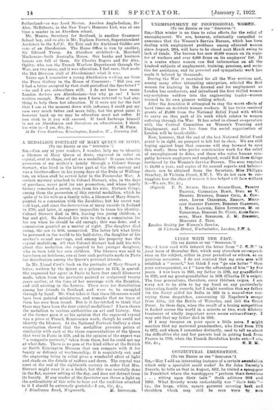A MEDALLION PORTRAIT OF MARY QUEEN OF SCOTS. [To THE
EDITOR or THE " SPECTATOR."] SIR,—Can any of your readers, I wonder, help me to identify a. likeness of Mary Queen of Scots, engraved in relief on crystal, oval in shape, and set as a medallion? It came into the possession of my mother's family through a Colonel George Stewart, who lived in the latter part of the 18th century and was a brother-officer in his young days of the Duke of Welling- ton, on whose staff be served later in the Peninsular War. A certain mystery attached to Colonel Stewart, who, in the days of purchase, never paid for any promotion, and whose family history remained a secret, even from his wife. Certain things, among them the possession of this crystal medallion, which he spoke of to his wife as a family relic, a likeness of Mary Stuart, pointed to a connexion with the Jacobites; but, his secret was well kept, and since the destruction of many records in Ireland in 1799, and later, it appears impossible to trace his identity. Colonel Stewart died in 1804, leaving two young children, a boy and girl. He desired his wife to claim a commission for his son when he should be old enough; this was done, and a commission granted as a matter of right. he daughter died young, the son in 1846, unmarried. The, latter left what little he possessed in the world to his half-sister, the daughter of his mother's second marriage, and among his property was the crystal medallions. All that Colonel Stewart had told his wife about this: medallion she repeated to her younger daughter, who in turn told her own children. The likeness was said to have been an heirloom, one of four such portraits made in Paris for distribution among the Queen's personal friends.
In Mr. Lionel Cust's book on the portraits of Mary Stuart a letter, written by the Queen as a prisoner in 1578, is quoted. Sho requested her agent in Paris to have four small likenesses made, taken from the portraits painted or sculptured twenty years earlier, at the time of her marriage with the Dauphin, and still existing in the Louvre. These were for distribution among her friends in Scotland, and were to be smuggled through by hand. Mr. Gust takes it that these likenesses would have been painted miniatures, and remarks that no trace of them has ever been found. But is it far-fetched to think that these may have been the four crystal medallions? I have shown the medallion to various authorities on art and history. One of the former gave it as his opinion that the engraved crystal was a piece of French Renaissance work, though he could not identify the likeness. At the National Portrait Gallery a close examination showed that the medallion presents points of similarity with each of the three representations of the Queen that were in Paris in 1578, and in the opinion of the expert was " a composite portrait," taken from these, but he could not say at what date. There is no gem of the kind either at the British or South Kensington Museum that can compare with it for beauty or delicacy of workmanship; it is exquisitely cut, and the engraving being in relief gives a wonderful effect of light and shade on the details of coiffure and dress. The crystal was reset at the end of the eighteenth century in order that Mrs. Stewart might wear it as a locket, but this was carefully done in the flat, narrow setting of the day, and does not detract from its beauty. If any reader of the Spectator can throw a light on the authenticity of this relic to bear out the tradition attached to it I should be extremely grateful.—I am, Sir, 4c.,
7 Bincleaves Road, Weymouth. it. 'unworn.










































 Previous page
Previous page